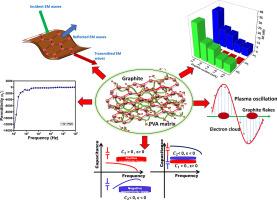近零响应和可变负介电常数的柔性聚乙烯醇-石墨复合材料的吸收显性电磁干扰屏蔽
IF 5.7
3区 材料科学
Q2 MATERIALS SCIENCE, MULTIDISCIPLINARY
引用次数: 0
摘要
由于其在电磁场中的潜在应用,具有负介电常数的本征超材料引起了人们极大的兴趣。本研究采用压铸法制备了不同石墨片浓度的聚乙烯醇(PVA) -石墨片(G)复合材料。在含有1 wt%石墨薄片(-0.71)的复合材料中观察到epsilon -近零行为。较高浓度的石墨颗粒在整个测试频率范围内保持负介电常数。3 wt%的石墨片加载使跳变导电性转变为类金属导电性。这些超复合材料为构建具有弱和可控负介电常数的材料提供了新的框架,从而简化了它们在微波吸收和电磁干扰(EMI)屏蔽方面的应用。在双层复合结构中观察到高的正介电常数和最小的介电损耗,夹在具有负和正介电常数的两层之间。此外,对x波段的电磁干扰屏蔽进行了深入的讨论,在2.5 wt%的石墨薄片中,屏蔽效率为-37 dB。本文章由计算机程序翻译,如有差异,请以英文原文为准。

Near–zero epsilon response and variable negative permittivity of flexible PVA-graphite metacomposites for absorption dominant electromagnetic interference shielding
There is tremendous interest in intrinsic metamaterials exhibiting negative permittivity, due to their potential applications in the electromagnetic field. In this investigation, polyvinyl alcohol (PVA)–graphite flakes (G) metacomposites were fabricated using die-casting method, with varying graphite flake concentrations. Epsilon-near-zero behavior was observed in the composite containing 1 wt% graphite flakes (-0.71). A higher concentration of graphite particles maintained negative permittivity throughout the tested frequency range. 3 wt% graphite flake loading changes hopping conduction into metal-like conduction. These metacomposites offer a new framework for constructing materials with weakly and controllably negative permittivity, thereby simplifying their application in microwave absorption and electromagnetic interference (EMI) shielding. A high positive permittivity and minimal dielectric loss were observed in a double-layer composite structure, sandwiched between two layers exhibiting negative and positive permittivity. Furthermore, EMI shielding was thoroughly discussed in the X-band region with a shielding efficiency of –37 dB with 2.5 wt% graphite flakes.
求助全文
通过发布文献求助,成功后即可免费获取论文全文。
去求助
来源期刊

Materials Research Bulletin
工程技术-材料科学:综合
CiteScore
9.80
自引率
5.60%
发文量
372
审稿时长
42 days
期刊介绍:
Materials Research Bulletin is an international journal reporting high-impact research on processing-structure-property relationships in functional materials and nanomaterials with interesting electronic, magnetic, optical, thermal, mechanical or catalytic properties. Papers purely on thermodynamics or theoretical calculations (e.g., density functional theory) do not fall within the scope of the journal unless they also demonstrate a clear link to physical properties. Topics covered include functional materials (e.g., dielectrics, pyroelectrics, piezoelectrics, ferroelectrics, relaxors, thermoelectrics, etc.); electrochemistry and solid-state ionics (e.g., photovoltaics, batteries, sensors, and fuel cells); nanomaterials, graphene, and nanocomposites; luminescence and photocatalysis; crystal-structure and defect-structure analysis; novel electronics; non-crystalline solids; flexible electronics; protein-material interactions; and polymeric ion-exchange membranes.
 求助内容:
求助内容: 应助结果提醒方式:
应助结果提醒方式:


